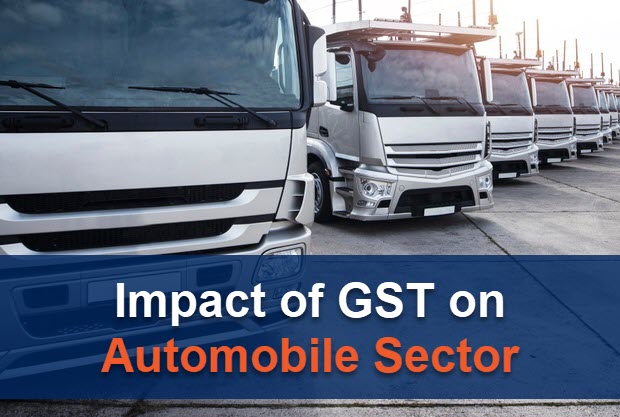The Indian automobile industry is one of the fastest-growing industries having a direct impact on automobiles and other reform policies by the Government.
Since the introduction of GST, the burden on the end consumers buying bikes or cars has been reduced as earlier the tax slabs of Excise & VAT were considerably higher than the current GST slabs of 18% & 28%.
In this short article, we will look at how GST impact on automobile sector has changed in India and some of the positive and negative impacts of GST on this sector.
We will also discuss the GST rates currently applicable on the purchase of automobiles.

Get Free Bonus Report: Claim 100% ITC for your business
Tax Rates on Automobiles in the Pre-GST Era
In the taxation system, the transactions involving sales/purchase automobiles attracted VAT and Excise duty on it.
Due to this, the purchase price of the vehicle would shoot up.
Following were some of the reasons for the highly inflated prices of automobiles in the pre-GST era:
Due to this, the dealers were finding loopholes in the system to evade taxes, which paved new ways to tax evasion practices.
The automobile dealers would practice tax evasion using the following means:
The following table shows the rate slabs in the pre-GST era for the automobile sector.
Category | Excise Duty | VAT | Cess | Road Tax | Motor Vehicle Tax | Total Sum |
|---|---|---|---|---|---|---|
Small-sized cars (<1200 cc) | 12.50% | 14% | 1.1% | As per state law | As per state law | 28% (approx.) |
Mid-sized cars (1200-1500 cc) | 24% | 14% | 1.1% | As per state law | As per state law | 39% (approx.) |
Luxury cars (>1500cc) | 27% | 14% | 1.1% | As per state law | As per state law | 42% (approx.) |
SUV (>1500cc) | 30% | 14% | 1.1% | As per state law | As per state law | 45% (approx.) |
From the table, you can see that the tax paid on the purchase of cars was as high as 45%. With the introduction of GST in India, there is a reduction in the total tax paid on the purchase of automobiles.
Slabs of GST on cars are as follows:
Category | CGST | GST | Total |
|---|---|---|---|
Small-sized cars (<1200 cc) | 9% | 9% | 18% |
Mid-sized cars (1200-1500 cc) | 9% | 9% | 18% |
Luxury cars (>1500cc) | 14% | 14% | 28% |
SUV (>1500cc) | 14% | 14% | 28% |
Electric Vehicles | 6% | 6% | 12% |
There is a considerable difference between the previous tax slabs and the current GST tax rate slabs.

Positive sides of GST on the automobile sector
Get Free Bonus Report: Claim 100% ITC for your business
The introduction has had positive impacts on the automobile industry in India.
Following are some reasons why the GST structure provides 'ease to do business ’ to the automobile sector.
Input Tax Credit under GST
Input Tax Credit under GST is the bedrock of the GST structure and one of the most lucrative features of the structure that makes it a justiciable tax.
Before GST, the importers and the vehicle dealers could not claim the VAT & Excise duty paid.
But under the GST regime, the importers and the vehicle dealers can claim the tax paid under CGST & SGST heads.
This will also keep the prices of the vehicles stable and will not see a sharp increase in the costs from its base price.
As a consumer: You can observe that the tax brackets had decreased than before, which led to a reduction in vehicle costs. Hence, as a consumer GST applied on automobiles has been proved beneficial to us.
As an importer or dealer – Dealers or importers are also satisfied with the GST applied as they can claim the tax paid with Input Tax Credit . Hence, it’s a win-win deal for both parties.
Curbing tax evasions
As discussed in the earlier section, the introduction has not only simplified the taxation structure but also curbed tax evasions to a certain extent. However, there is plenty of room for improvement in the GST structure to minimize the tax-evading practices.
As far as the automobile industry is concerned, uniformity in the tax structure is maintained, keeping the selling prices of the cars with minimal differences, if not the same.
It has helped merge the point of sales and the delivery showroom locations.
On the consumer's side: Consumers no longer have to pay tax arbitrages that they had to pay earlier due to the state-level differences.
On the Government’ side – Due to the tax evasions being reduced, the revenue of the Government is increasing considerably. This helps the Government to invest in public projects and policies.
Interstate goods of sales are now simplified
Before GST, Central Sales Tax was levied on the interstate sales of the vehicles. Therefore, the credit availed on this tax was not eligible to pay the outstanding VAT liabilities.
With the introduction, the Integrated GST (IGST), this problem is now addressed. IGST is now applicable on interstate sales of goods and services. Hence, dealers can now claim Input Tax Credit on the tax paid on these transactions.
Dealers can also avail of the tax credit on overheads like advertisements and rent. This has also helped the companies to bring down the operating costs.
Subsidies available on specific categories of vehicles
Under the GST regime, the Government has allowed huge subsidies on the ‘Electric Vehicles’ to encourage clean and green transportation.
The GST rates have also been cut down from 18% to the current 12%.
According to the GST laws, if the subsidy is claimed on any electric vehicle, the it will be applied on the transaction value minus the subsidy amount.
For example: If an electric car costs 7,50,000 and the government provides a subsidy on 1,50,000, it means that now the GST will be applicable on (7,50,000-1,50,000 = 6,00,000).
The Government has subsidized 1,50,000.
Following are some of the significant expectations from the Electric Vehicle industry of our country:
The subsidies and the lower GST rates will encourage consumers to buy electric vehicles, which will positively impact the environment.

Get Free Bonus Report: Claim 100% ITC for your business
There are some shortfalls that the automobile sector has been facing since the introduction of the GST.
Following are some of the negative impacts of GST rate on cars or as a whole on the automobile sector:
Exclusion of discount value while calculating GST
- Consumers tend to get lured into buying goods or services when an attractive discount or promotional price is offered.
- In the Indian market, it is common that the dealers often offer a discount on the vehicles. At the same time, the manufacturer or the importer may also provide a reasonable discount to the dealer.
- When the invoice is prepared for either of the transactions, the GST is calculated on the supply value, excluding the discount price. This can be a loophole that can be taken advantage of in the taxation system.
Vouchers & warranty cards are also taxed
- It is a standard practice that the vehicle dealership issues vouchers and warranty cards to the customers.
- According to the GST laws, the vouchers and the warranty cards are considered under the 'after-sales' services, and GST is charged on them when they are issued.
In a Nutshell
The introduction of GST in India has positively impacted the automobile industry in India. However, there is still some room for improvement to cut down on tax slabs so that the ordinary person could easily afford to buy a vehicle.
Due to the COVID-19 impact, the automobile industry has seen a steep decline in sales. However, the industry is now picking up the pace to recover from the pandemic impact.
Consumers are now moving from luxury choices towards more economically sustainable preferences like buying small vehicles like Alto or Datsun.
A crisis indeed enables a paradigm shift in consumer behavior!
In this short article, we have covered some significant impacts of the GST structure on the automobile industry in India.
Until the next time….

Claim upto 100% Input Tax Credit
Easiest GSTR 2B Reconciliation With Reverse ERP Integration

